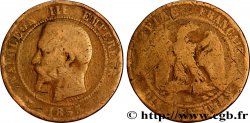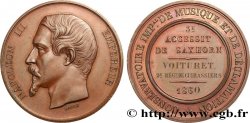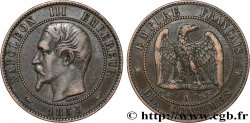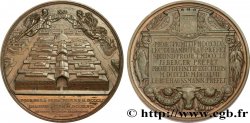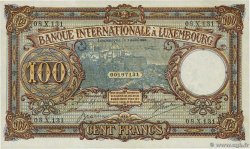E-auction 292-212802 - fme_412082 - SECOND EMPIRE Médaille de l’exposition de Dijon
You must signin and be an approved bidder to bid, LOGIN TO BID. Accounts are subject to approval and the approval process takes place within 48 hours. Do not wait until the day a sale closes to register. Clicking on « bid » constitutes acceptance of the terms of use of cgb.fr private e-auctions.
Bids must be placed in whole Euro amounts only. The sale will start closing at the time stated on the item description; any bids received at the site after the closing time will not be executed. Transmission times may vary and bids could be rejected if you wait until the last second. For further information ckeck the E-auctions F.A.Q.
NO BUYER'S FEE.
NO BUYER'S FEE.
| Estimate : | 150 € |
| Price : | 35 € |
| Maximum bid : | 35 € |
| End of the sale : | 19 November 2018 18:46:30 |
| bidders : | 9 bidders |
Type : Médaille de l’exposition de Dijon
Date: 1858
Mint name / Town : 21 - Dijon
Metal : copper
Diameter : 56,5 mm
Orientation dies : 12 h.
Engraver CHABAUD Louis-Félix (1824-1902)
Weight : 98 g.
Edge : lisse + main CUIVRE
Coments on the condition:
Médaille avec un superbe avers et quelques traces de manipulation au revers. Très agréable patine brune
Obverse
Obverse legend : NAPOLÉON III EMPEREUR.
Obverse description : Tête nue de Napoléon III à gauche.
Reverse
Reverse legend : INDUSTRIE BEAU-ARTS AGRICULTURE * 1858 * // EXPOSITION / DE DIJON / MÉDAILLE DE 3E CLASSE / À / BOUTARDS & LASSALLE.
Reverse description : Légende circulaire puis en 5 lignes horizontales.
Commentary
Médaille attribuée à boutards & lassalle.
Louis-Félix Chabaud, né le 14 mars 1824 à Venelles (Bouches-du-Rhône), où il est mort le 25 avril 1902, est un sculpteur et médailleur français. Fils d’agriculteur, Louis-Félix Chabaud fréquente l’école communale de Venelles jusqu’en 1836 et entre en apprentissage chez un boulanger, puis chez un marbrier aixois, M. Raimond. Il commence ses études à l’école des beaux-arts d’Aix-en-Provence avec Joseph Marius Ramus et les termine à l'École des beaux-arts de Paris sous la direction de James Pradier. Le 9 septembre 1848 il remporte le 1er grand prix de Rome en gravure de médailles et pierres fines pour son Mercure formant le caducée. Il séjourne à Rome pendant quatre ans, pensionnaire de l’État à la villa Médicis.
De retour à Paris, il expose au Salon de 1853 et obtient le 3e prix pour L’Agriculture (bronze) et Cérès embrassant Triptolème. En 1855 il est également primé pour une série de médailles : Agriculture, Napoléon III et une tête de femme. En 1857, il est à nouveau primé pour une sculpture en plâtre représentant La Chasse, acquise par l’État français. En 1859, douze camées en pierres fines lui valent le prix de la gravure et il reçoit, en 1863, une 3e médaille pour une statue de L’Agriculture et un bas-relief intitulé L'Abolition de l’esclavage.
Réputé comme sculpteur ornemaniste, il participe au chantier de décoration du Palais Garnier à Paris.
L’Exposition internationale de 1858 s'est déroulée dans la ville française de Dijon (Côte-d'Or) afin de promouvoir les Beaux-arts, l'industrie et l'agriculture. L'Exposition a été inaugurée le 8 juin 1858 par Jean-Baptiste Philibert Vaillant et s'est tenue jusqu'à septembre 1858 place d'Armes (actuelle place de la Libération) au cœur de la capitale des ducs de Bourgogne à l'initiative du maire de la ville Théodore Michel Vernier, président de la commission. Elle devait promouvoir les Beaux-arts, l'industrie et l'agriculture et a ainsi exposé objets et produits dans les salles de l'ancien palais des Ducs de Bourgogne et dans les annexes de la La place d'Armes, de la place du Théâtre et de la place des Ducs. Une valse pour piano La Dijonnaise a été spécialement écrite pour l'événement par madame Alexandre Bataille et dédiée aux membres de la commission de l'exposition..
Louis-Félix Chabaud, né le 14 mars 1824 à Venelles (Bouches-du-Rhône), où il est mort le 25 avril 1902, est un sculpteur et médailleur français. Fils d’agriculteur, Louis-Félix Chabaud fréquente l’école communale de Venelles jusqu’en 1836 et entre en apprentissage chez un boulanger, puis chez un marbrier aixois, M. Raimond. Il commence ses études à l’école des beaux-arts d’Aix-en-Provence avec Joseph Marius Ramus et les termine à l'École des beaux-arts de Paris sous la direction de James Pradier. Le 9 septembre 1848 il remporte le 1er grand prix de Rome en gravure de médailles et pierres fines pour son Mercure formant le caducée. Il séjourne à Rome pendant quatre ans, pensionnaire de l’État à la villa Médicis.
De retour à Paris, il expose au Salon de 1853 et obtient le 3e prix pour L’Agriculture (bronze) et Cérès embrassant Triptolème. En 1855 il est également primé pour une série de médailles : Agriculture, Napoléon III et une tête de femme. En 1857, il est à nouveau primé pour une sculpture en plâtre représentant La Chasse, acquise par l’État français. En 1859, douze camées en pierres fines lui valent le prix de la gravure et il reçoit, en 1863, une 3e médaille pour une statue de L’Agriculture et un bas-relief intitulé L'Abolition de l’esclavage.
Réputé comme sculpteur ornemaniste, il participe au chantier de décoration du Palais Garnier à Paris.
L’Exposition internationale de 1858 s'est déroulée dans la ville française de Dijon (Côte-d'Or) afin de promouvoir les Beaux-arts, l'industrie et l'agriculture. L'Exposition a été inaugurée le 8 juin 1858 par Jean-Baptiste Philibert Vaillant et s'est tenue jusqu'à septembre 1858 place d'Armes (actuelle place de la Libération) au cœur de la capitale des ducs de Bourgogne à l'initiative du maire de la ville Théodore Michel Vernier, président de la commission. Elle devait promouvoir les Beaux-arts, l'industrie et l'agriculture et a ainsi exposé objets et produits dans les salles de l'ancien palais des Ducs de Bourgogne et dans les annexes de la La place d'Armes, de la place du Théâtre et de la place des Ducs. Une valse pour piano La Dijonnaise a été spécialement écrite pour l'événement par madame Alexandre Bataille et dédiée aux membres de la commission de l'exposition..








 Report a mistake
Report a mistake Print the page
Print the page Share my selection
Share my selection Ask a question
Ask a question Consign / sell
Consign / sell
 Full data
Full data